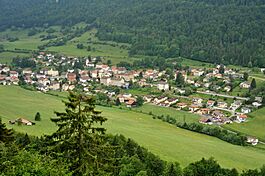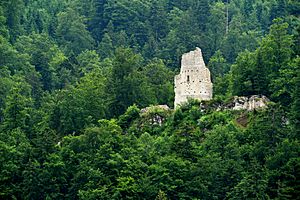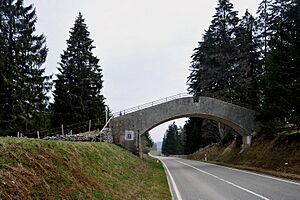Sonvilier facts for kids
Quick facts for kids
Sonvilier
|
||
|---|---|---|

Sonvilier village from the ruins of Erguel Castle
|
||
|
||
| Country | Switzerland | |
| Canton | Bern | |
| District | Jura bernois | |
| Area | ||
| • Total | 23.78 km2 (9.18 sq mi) | |
| Elevation | 802 m (2,631 ft) | |
| Population
(Dec 2020 )
|
||
| • Total | 1,223 | |
| • Density | 51.43/km2 (133.20/sq mi) | |
| Postal code |
2615
|
|
| Surrounded by | Renan, Saint-Imier, Les Bois, Le Pâquier, Dombresson, Chézard-Saint-Martin | |
Sonvilier is a small town, also called a municipality, located in the Jura bernois administrative district in the canton of Bern in Switzerland. It is found in the French-speaking part of Switzerland known as the Bernese Jura.
Contents
History of Sonvilier
Sonvilier was first mentioned in old records in 1298 as Sunuilier. A few years later, in 1307, it was called Sonvelier.
Erguel Castle and its Rulers
Erguel Castle, which is now just ruins, was built in the 11th century southeast of the village. This castle was the main place of power for the Lords of Erguel, who ruled the surrounding lands.
In 1264, Otto von Erguel, who lived in Basel, gave his lands to the Prince-Bishop of Basel. A Prince-Bishop was a bishop who also had political power over a region. In return, the bishop gave Otto lands in Alsace. Under the Prince-Bishop, the Erguel lands, including Sonvilier, became part of a larger area called the seigniory of Erguel. A seigniory was a territory ruled by a lord.
During the 13th and 14th centuries, a local noble family from Sonvilier was mentioned in historical documents. In the 16th century, Sonvilier was the biggest municipality in the Erguel area. It had about six mills that were held as a fief by the Prince-Bishop of Basel. A fief was land granted in exchange for loyalty or service.
Changes in Government
After the French won battles in 1797 during the French Revolutionary Wars, Sonvilier became part of a French Département called Mont-Terrible. A Département is like a large county in France. Three years later, in 1800, it became part of the Département of Haut-Rhin.
After Napoleon was defeated and the Congress of Vienna took place, Sonvilier was given to the Canton of Bern in 1815. A canton is like a state in Switzerland.
Social Movements and Religion
Two important social movements started in Sonvilier in the 1800s. In 1843, Fritz Marchand created a group called L'Union Society, which focused on helping people.
Almost 30 years later, in 1871, a group called the Fédération jurassienne (Jura Federation) was formed in the village. This group was a federalist and anarchist part of the International Workingmen's Association. Federalist means they believed in local power, and anarchist means they wanted to get rid of all government. The leader of the Jura Federation, Mikhail Bakunin, held three meetings in Sonvilier in 1871.
Religiously, Sonvilier was part of the parish of Saint-Imier. A parish is a church district. A Reformed church was built in the village in 1832. A Mennonite chapel was built in La Chaux-d'Abel in 1905.
Economy and Transportation Growth
During the 1700s and 1800s, the local economy grew. Many people worked from home making watches and lace. This was called the Putting-out system, where people made parts at home for a larger company. Several small workshops made watch parts that were then put together in other towns.
However, financial problems in the 1930s and 1970s severely hurt the watchmaking industry. Many workshops had to close. By 2005, only 9% of jobs in Sonvilier were in manufacturing, while almost half were in farming.
In 1874, the railway line connecting Biel to Les Convers was finished. This connected Sonvilier to the national train network. In 1895, the canton bought a farm called Le Pré aux Boeuf and turned it into a boarding school for boys. In 1931, it became a home for people who needed help.
Geography of Sonvilier
Sonvilier covers an area of about 23.78 square kilometers (9.18 square miles). A large part of this land, about 60.8%, is used for farming. Forests cover about 34.4% of the area.
About 4.5% of the land is developed with buildings or roads. A very small part, 0.1%, is rivers or lakes, and 0.2% is unproductive land.
The municipality is located above the Suze river valley in the Bernese Jura mountains. Sonvilier includes the main village, which is a haufendorf village. This means it's an irregular, unplanned, and closely packed village built around a central area. It also includes the small village, or hamlet, of La Chaux-d'Abel, and many scattered farmhouses on the slopes of the Montagne du Droit and the Montagne de l'Envers.
On December 31, 2009, the old district of Courtelary, where Sonvilier belonged, was closed down. The next day, January 1, 2010, Sonvilier became part of the new administrative district called Arrondissement administratif Jura bernois.
Coat of Arms
The blazon (description) of Sonvilier's municipal coat of arms is: Gules a Banderole Argent in bend. This means it has a red background with a silver banner or ribbon placed diagonally.
Population of Sonvilier
Sonvilier has a population of about 1,200 people. As of 2010, about 9.8% of the people living there were foreign nationals. Over the past 10 years (2000-2010), the population grew by 9.7%. This growth was mostly due to more births than deaths, and people moving into the area.
Most people in Sonvilier (about 76.8%) speak French as their first language. German is the second most common language (17.7%), and Italian is third (1.9%).
In 2010, children and teenagers (ages 0–19) made up 25.5% of the population. Adults (ages 20–64) made up 57.3%, and seniors (over 64 years old) made up 17.2%.
In 2000, about 31.5% of the people living in Sonvilier were born there. Another 25.8% were born in the same canton (Bern). About 26.7% were born elsewhere in Switzerland, and 11.7% were born outside Switzerland.
The chart below shows how the population of Sonvilier has changed over time:

Important Heritage Site
The Ferme De La Grande Coronelle (Grande Coronelle Farm) is a very important building in Switzerland. It is listed as a heritage site of national significance. This means it's a special place that is protected because of its history or culture.
Economy of Sonvilier
In 2011, Sonvilier had a low unemployment rate of 2.57%, meaning most people who wanted jobs had them. In 2008, there were 269 people working in the municipality.
Types of Jobs
Jobs are often divided into three main groups:
- Primary sector: These jobs involve getting raw materials from nature. In Sonvilier, 119 people worked in this sector, mostly in farming. There were about 45 businesses in this area.
- Secondary sector: These jobs involve making things. In Sonvilier, 24 people worked in this sector, with 8 businesses. Some worked in manufacturing (making goods), and others in construction (building things).
- Tertiary sector: These jobs involve providing services. In Sonvilier, 126 people worked in this sector, with 26 businesses. This included jobs in sales, hotels, restaurants, technical work, education, and healthcare.
In 2008, there were 204 full-time equivalent jobs. This means if you add up all the hours worked, it's like 204 people working full-time.
Commuting and Travel
In 2000, 78 workers came into Sonvilier for their jobs, while 346 workers left Sonvilier to work elsewhere. This means more people leave Sonvilier for work than come in. About 5.1% of the workers coming into Sonvilier were from outside Switzerland.
When it came to getting to work, 10.3% of the working population used public transportation, like trains or buses. A much larger group, 61%, used a private car.
Religion in Sonvilier
Based on the 2000 census, about 21.3% of the people in Sonvilier were Roman Catholic. The largest group, about 54.1%, belonged to the Swiss Reformed Church.
There were also smaller numbers of people who belonged to other Christian churches, including Orthodox and Christian Catholic. A small number of people were Jewish or Islamic. There were also a few Buddhists.
About 11.14% of the population said they belonged to no church, or were agnostic (not sure if God exists) or atheist (do not believe in God).
Education in Sonvilier
In Sonvilier, about 35.1% of the population has finished upper secondary education, which is like high school. About 7.9% have gone on to higher education, either at a university or a specialized college called a Fachhochschule.
School System
The Canton of Bern has a specific school system:
- One year of non-required Kindergarten.
- Six years of Primary school.
- Three years of required lower Secondary school. In this stage, students are grouped based on their abilities.
- After lower Secondary, students can continue their schooling or start an apprenticeship, which is on-the-job training.
During the 2010-2011 school year, 110 students attended schools in Sonvilier. There were 2 kindergarten classes with 27 students. In these classes, some students were not Swiss citizens, and some spoke a different first language than the classroom language. There were 4 primary classes with 83 students.
In 2000, 34 students came to Sonvilier to attend school from other towns. At the same time, 110 students from Sonvilier went to schools outside the municipality.
Local Library
Sonvilier has a library called the Bibliothèque communale et scolaire de Sonvilier (Community and School Library of Sonvilier). In 2008, the library had 11,422 books and other media. It loaned out 12,898 items that year. The library was open for a total of 90 days, averaging 4 hours per week.
Transportation
Sonvilier has its own railway station, Sonvilier. This station is on the Biel/Bienne–La Chaux-de-Fonds line. Trains run every hour, connecting Sonvilier to Biel/Bienne and La Chaux-de-Fonds.
Famous People from Sonvilier
- Louis-Ulysse Chopard: A famous watchmaker and manufacturer who was born in Sonvilier.
- Ferdinand Gonseth: A Swiss mathematician and philosopher who was born in Sonvilier.
See also
 In Spanish: Sonvilier para niños
In Spanish: Sonvilier para niños









